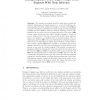Free Online Productivity Tools
i2Speak
i2Symbol
i2OCR
iTex2Img
iWeb2Print
iWeb2Shot
i2Type
iPdf2Split
iPdf2Merge
i2Bopomofo
i2Arabic
i2Style
i2Image
i2PDF
iLatex2Rtf
Sci2ools
118
click to vote
TABLEAUX
2009
Springer
2009
Springer
Taming Displayed Tense Logics Using Nested Sequents with Deep Inference
We consider two sequent calculi for tense logic in which the syntactic judgements are nested sequents, i.e., a tree of traditional onesided sequents built from multisets of formulae. Our first calculus SKt is a variant of Kashima’s calculus for Kt, which can also be seen as a display calculus, and uses “shallow” inference whereby inference rules are only applied to the top-level nodes in the nested structures. The rules of SKt include certain structural rules, called “display postulates”, which are used to bring a node to the top level and thus in effect allow inference rules to be applied to an arbitrary node in a nested sequent. The cut elimination proof for SKt uses a proof substitution technique similar to that used in cut elimination for display logics. We then consider another, more natural, calculus DKt which contains no structural rules (and no display postulates), but which uses deep-inference to apply inference rules directly at any node in a nested sequent. This ...
| Added | 27 May 2010 |
| Updated | 27 May 2010 |
| Type | Conference |
| Year | 2009 |
| Where | TABLEAUX |
| Authors | Rajeev Goré, Linda Postniece, Alwen Tiu |
Comments (0)

